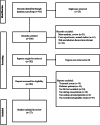Performance of Intra-arrest Echocardiography: A Systematic Review
- PMID: 38596913
- PMCID: PMC11000560
- DOI: 10.5811/westjem.18440
Performance of Intra-arrest Echocardiography: A Systematic Review
Abstract
Introduction: Intra-arrest transthoracic echocardiography (TTE) and transesophageal echocardiography (TEE) have been introduced in adult patients with cardiac arrest (CA). Whether the diagnostic performance of TTE or TEE is superior during resuscitation is unclear. We conducted a systematic review following PRISMA guidelines.
Methods: We searched databases from PubMed, Embase, and Google Scholar and evaluated articles with intra-arrest TTE and TEE in adult patients with non-traumatic CA. Two authors independently screened and selected articles for inclusion; they then dual-extracted study characteristics and target conditions (pericardial effusion, aortic dissection, pulmonary embolism, myocardial infarction, hypovolemia, left ventricular dysfunction, and sonographic cardiac activity). We performed quality assessment using the Quality Assessment of Diagnostic Accuracy Studies Version 2 criteria.
Results: A total of 27 studies were included: 14 studies with 2,145 patients assessed TTE; and 16 with 556 patients assessed TEE. A high risk of bias or applicability concerns in at least one domain was present in 20 studies (74%). Both TTE and TEE found positive findings in nearly one-half of the patients. The etiology of CA was identified in 13% (271/2,145), and intervention was performed in 38% (102/271) of patients in the TTE group. In patients who received TEE, the etiology was identified in 43% (239/556), and intervention was performed in 28% (68/239). In the TEE group, a higher incidence regarding the etiology of CA was observed, particularly for those with aortic dissection. However, the outcome of those with aortic dissection in the TEE group was poor.
Conclusion: While TEE could identify more causes of CA than TTE, sonographic cardiac activity was reported much more in the TTE group. The impact of TTE and TEE on the return of spontaneous circulation and further survival was still inconclusive in the current dataset.
Conflict of interest statement
Figures
Similar articles
-
[Value of transesophageal echocardiography in the assessment of blunt chest trauma: correlation with electrocardiogram, heart enzymes, and transthoracic echocardiogram].Rev Port Cardiol. 1994 Nov;13(11):833-43, 807-8. Rev Port Cardiol. 1994. PMID: 7848654 Clinical Trial. Portuguese.
-
Diagnostic potential of combined transthoracic echocardiography and x-ray computed tomography in suspected aortic dissection.Clin Cardiol. 1999 May;22(5):345-52. doi: 10.1002/clc.4960220510. Clin Cardiol. 1999. PMID: 10326167 Free PMC article.
-
Diagnostic accuracy and therapeutic impact of transthoracic and transesophageal echocardiography in mechanically ventilated patients in the ICU.Chest. 1994 Dec;106(6):1829-34. doi: 10.1378/chest.106.6.1829. Chest. 1994. PMID: 7988209
-
Considerations for the Use of Intracardiac Echocardiography in Cardiac Arrest.Resuscitation. 2020 Apr;149:158-161. doi: 10.1016/j.resuscitation.2020.02.003. Epub 2020 Feb 25. Resuscitation. 2020. PMID: 32109504 Review.
-
Diagnostic Yield of TEE in Patients with Cryptogenic Stroke and TIA with Normal TTE: A Systematic Review and Meta-Analysis.Neurol Int. 2021 Dec 1;13(4):659-670. doi: 10.3390/neurolint13040063. Neurol Int. 2021. PMID: 34940749 Free PMC article. Review.
Cited by
-
Point-of-Care Ultrasound Use in Hemodynamic Assessment.Biomedicines. 2025 Jun 10;13(6):1426. doi: 10.3390/biomedicines13061426. Biomedicines. 2025. PMID: 40564145 Free PMC article. Review.
-
Ultrasound during Advanced Life Support-Help or Harm?Diagnostics (Basel). 2024 Mar 11;14(6):593. doi: 10.3390/diagnostics14060593. Diagnostics (Basel). 2024. PMID: 38535014 Free PMC article.
References
-
- Wyckoff MH, Greif R, Morley PT, et al. . 2022 International Consensus on Cardiopulmonary Resuscitation and Emergency Cardiovascular Care Science with Treatment Recommendations: summary from the Basic Life Support; Advanced Life Support; Pediatric Life Support; Neonatal Life Support; Education, Implementation, and Teams; and First Aid Task Forces. Circulation. 2022;146(25):e483–557. - PubMed
-
- Breitkreutz R, Price S, Steiger HV, et al. . Focused echocardiographic evaluation in life support and peri-resuscitation of emergency patients: a prospective trial. Resuscitation. 2010;81(11):1527–33. - PubMed
-
- Gaspari R, Weekes A, Adhikari S, et al. . Emergency department point-of-care ultrasound in out-of-hospital and in-ED cardiac arrest. Resuscitation. 2016;109:33–9. - PubMed
-
- Hernandez C, Shuler K, Hannan H, et al. . C.A.U.S.E.: cardiac arrest ultrasound exam--a better approach to managing patients in primary non-arrhythmogenic cardiac arrest. Resuscitation. 2008;76(2):198–206. - PubMed
-
- Clattenburg EJ, Wroe PC, Gardner K, et al. . Implementation of the cardiac arrest sonographic assessment (CASA) protocol for patients with cardiac arrest is associated with shorter CPR pulse checks. Resuscitation. 2018;131:69–73. - PubMed

